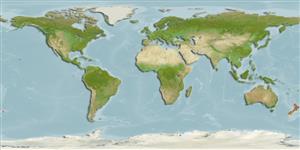>
Ovalentaria/misc (Various families in series Ovalentaria) >
Plesiopidae (Roundheads) > Acanthoclininae
Etymology: Acanthoclinus: Greek, akantha = thorn + Greek, klinein, kline = sloping and bed, due to the four apophyses of sphenoid bone (Ref. 45335).
Environment: milieu / climate zone / depth range / distribution range
पारिस्थितिकी
समुद्री ड़िमरसल; गैर प्रवासी; गहराई सीमा 0 - 80 m (Ref. 9003). Temperate
Southwest Pacific: endemic to New Zealand.
आकार / वज़न / Age
Maturity: Lm ? range ? - ? cm
Max length : 11.5 cm TL पुल्लिंग / अलिंग; (Ref. 9003)
Short description
पहचान कुंजी | आकृति विज्ञान | मौरफोमैटरिक्स
पृष्ठीय रीढ़ (सम्पूर्ण) : 12 - 14; पृष्ठीय सौफट रेज़ (सम्पूर्ण) : 3 - 4; गुदा कांटा: 14 - 15; ऐनल सौफट रेज़: 3 - 4. Head and body uniformly brown with a darker blotch on the gill cover. Forehead with a pale stripe. Dorsal and anal fins with orange tips. Distinguished from other rockfishes by its small size, undivided lower lateral line and the single pair of pores on the chin.
Adults occur in the subtidal zone but may be found in rock pools at low tide (Ref. 9003). Eggs are guarded by the male parent (Ref. 205).
Life cycle and mating behavior
Maturities | पुनरुत्पत्ति | Spawnings | Egg(s) | Fecundities | लार्वा
Eggs are guarded by the male parent (Ref. 205).
Paulin, C. and C. Roberts, 1992. The rockpool fishes of New Zealand (Te ika aaria o Aotearoa). Museum of New Zealand (Te Papa Tongarewa). 177 p. (Ref. 9003)
IUCN Red List Status (Ref. 130435)
Threat to humans
Harmless
Human uses
मात्स्यिकी: कोई रुचि बग़ैर
साधन
Special reports
Download XML
इंटरनेट स्रोत
Estimates based on models
Phylogenetic diversity index (Ref.
82804): PD
50 = 0.5312 [Uniqueness, from 0.5 = low to 2.0 = high].
Bayesian length-weight: a=0.00457 (0.00180 - 0.01158), b=3.10 (2.87 - 3.33), in cm total length, based on LWR estimates for this (Sub)family-body shape (Ref.
93245).
Trophic level (Ref.
69278): 3.4 ±0.6 se; based on size and trophs of closest relatives
लौटाव (Ref.
120179): ऊंचा, न्यूनतम जनसंख्या दुगनी समय अवलागत 15 महीने। (Preliminary K or Fecundity.).
Fishing Vulnerability (Ref.
59153): Low vulnerability (10 of 100).
